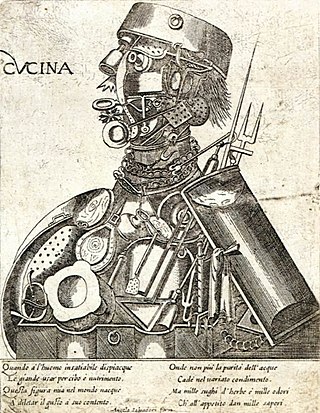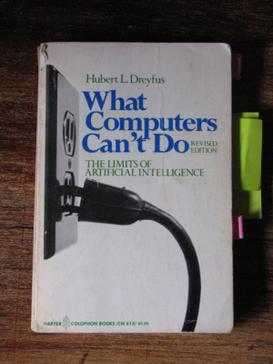Artificial intelligence (AI), in its broadest sense, is intelligence exhibited by machines, particularly computer systems. It is a field of research in computer science that develops and studies methods and software which enable machines to perceive their environment and uses learning and intelligence to take actions that maximize their chances of achieving defined goals. Such machines may be called AIs.
The Chinese room argument holds that a digital computer executing a program cannot have a "mind", "understanding", or "consciousness", regardless of how intelligently or human-like the program may make the computer behave. Philosopher John Searle presented the argument in his paper "Minds, Brains, and Programs", published in Behavioral and Brain Sciences in 1980. Gottfried Leibniz (1714), Anatoly Dneprov (1961), Lawrence Davis (1974) and Ned Block (1978) presented similar arguments. Searle's version has been widely discussed in the years since. The centerpiece of Searle's argument is a thought experiment known as the Chinese room.
The technological singularity—or simply the singularity—is a hypothetical future point in time at which technological growth becomes uncontrollable and irreversible, resulting in unforeseeable consequences for human civilization. According to the most popular version of the singularity hypothesis, I. J. Good's intelligence explosion model, an upgradable intelligent agent will eventually enter a positive feedback loop of self-improvement cycles, each new and more intelligent generation appearing more and more rapidly, causing a rapid increase ("explosion") in intelligence which ultimately results in a powerful superintelligence that qualitatively far surpasses all human intelligence.

The Age of Spiritual Machines: When Computers Exceed Human Intelligence is a non-fiction book by inventor and futurist Ray Kurzweil about artificial intelligence and the future course of humanity. First published in hardcover on January 1, 1999, by Viking, it has received attention from The New York Times, The New York Review of Books and The Atlantic. In the book Kurzweil outlines his vision for how technology will progress during the 21st century.

Mind uploading is a speculative process of whole brain emulation in which a brain scan is used to completely emulate the mental state of the individual in a digital computer. The computer would then run a simulation of the brain's information processing, such that it would respond in essentially the same way as the original brain and experience having a sentient conscious mind.
Artificial consciousness (AC), also known as machine consciousness (MC), synthetic consciousness or digital consciousness, is the consciousness hypothesized to be possible in artificial intelligence. It is also the corresponding field of study, which draws insights from philosophy of mind, philosophy of artificial intelligence, cognitive science and neuroscience. The same terminology can be used with the term "sentience" instead of "consciousness" when specifically designating phenomenal consciousness.
Bio-inspired computing, short for biologically inspired computing, is a field of study which seeks to solve computer science problems using models of biology. It relates to connectionism, social behavior, and emergence. Within computer science, bio-inspired computing relates to artificial intelligence and machine learning. Bio-inspired computing is a major subset of natural computation.
Neuromorphic computing is an approach to computing that is inspired by the structure and function of the human brain. A neuromorphic computer/chip is any device that uses physical artificial neurons to do computations. In recent times, the term neuromorphic has been used to describe analog, digital, mixed-mode analog/digital VLSI, and software systems that implement models of neural systems. The implementation of neuromorphic computing on the hardware level can be realized by oxide-based memristors, spintronic memories, threshold switches, transistors, among others. Training software-based neuromorphic systems of spiking neural networks can be achieved using error backpropagation, e.g., using Python based frameworks such as snnTorch, or using canonical learning rules from the biological learning literature, e.g., using BindsNet.
Artificial general intelligence (AGI) is a type of artificial intelligence (AI) that can perform as well or better than humans on a wide range of cognitive tasks. This is in contrast to narrow AI, which is designed for specific tasks. AGI is considered one of various definitions of strong AI.
A cognitive architecture refers to both a theory about the structure of the human mind and to a computational instantiation of such a theory used in the fields of artificial intelligence (AI) and computational cognitive science. The formalized models can be used to further refine a comprehensive theory of cognition and as a useful artificial intelligence program. Successful cognitive architectures include ACT-R and SOAR. The research on cognitive architectures as software instantiation of cognitive theories was initiated by Allen Newell in 1990.
A physical symbol system takes physical patterns (symbols), combining them into structures (expressions) and manipulating them to produce new expressions.
The philosophy of artificial intelligence is a branch of the philosophy of mind and the philosophy of computer science that explores artificial intelligence and its implications for knowledge and understanding of intelligence, ethics, consciousness, epistemology, and free will. Furthermore, the technology is concerned with the creation of artificial animals or artificial people so the discipline is of considerable interest to philosophers. These factors contributed to the emergence of the philosophy of artificial intelligence.
Neuroinformatics is the emergent field that combines informatics and neuroscience. Neuroinformatics is related with neuroscience data and information processing by artificial neural networks. There are three main directions where neuroinformatics has to be applied:
In philosophy of mind, the computational theory of mind (CTM), also known as computationalism, is a family of views that hold that the human mind is an information processing system and that cognition and consciousness together are a form of computation. Warren McCulloch and Walter Pitts (1943) were the first to suggest that neural activity is computational. They argued that neural computations explain cognition. The theory was proposed in its modern form by Hilary Putnam in 1967, and developed by his PhD student, philosopher, and cognitive scientist Jerry Fodor in the 1960s, 1970s, and 1980s. It was vigorously disputed in analytic philosophy in the 1990s due to work by Putnam himself, John Searle, and others.
The following outline is provided as an overview of and topical guide to artificial intelligence:

Hubert Dreyfus was a critic of artificial intelligence research. In a series of papers and books, including Alchemy and AI(1965), What Computers Can't Do and Mind over Machine(1986), he presented a pessimistic assessment of AI's progress and a critique of the philosophical foundations of the field. Dreyfus' objections are discussed in most introductions to the philosophy of artificial intelligence, including Russell & Norvig (2021), a standard AI textbook, and in Fearn (2007), a survey of contemporary philosophy.
In the field of computational neuroscience, Brain simulation is the concept of creating a functioning computer model of a brain or part of a brain. Brain simulation projects intend to contribute to a complete understanding of the brain, and eventually also assist the process of treating and diagnosing brain diseases. Simulations utilize mathematical models of biological neurons, such as the hodgkin-huxley model, to simulate the behavior of neurons, or other cells within the brain.

How to Create a Mind: The Secret of Human Thought Revealed is a non-fiction book about brains, both human and artificial, by the inventor and futurist Ray Kurzweil. First published in hardcover on November 13, 2012 by Viking Press it became a New York Times Best Seller. It has received attention from The Washington Post, The New York Times and The New Yorker.
A cognitive computer is a computer that hardwires artificial intelligence and machine learning algorithms into an integrated circuit that closely reproduces the behavior of the human brain. It generally adopts a neuromorphic engineering approach. Synonyms include neuromorphic chip and cognitive chip.
Hypothetical technology is technology that does not exist yet, but that could exist in the future. This article presents examples of technologies that have been hypothesized or proposed, but that have not been developed yet. An example of hypothetical technology is teleportation.




